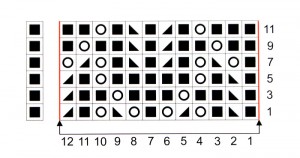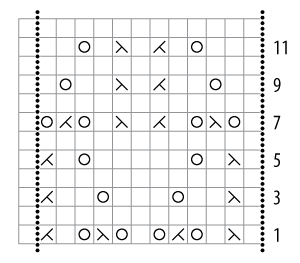To each their own
By JC | November 28, 2011
One of the reasons I love charts is that they’re a sort of universal language. It doesn’t matter where a chart comes from – a publication written in English, German, Japanese, or whatever – I’m good to go as long as I have an English copy of the key, or a few good swatch photos and some willingness to guess.
That doesn’t mean chart symbols are universal. Take the chart for Half Leaf, as it appears in The Happsalu Shawl:
The chart is perfectly understandable if you have its key. Even without the key, experienced knitters can guess that a circle is a yarn over, a triangle that slants right is a k2tog, and a triangle that slants left is an ssk.
But pretty? Easy to work with? Not so much, IMHO. I find the chart too busy, too cluttered. I’m not keen on the heavy, dark squares for knit stitches.
No biggie. I can always redraw a chart, using symbols more to my liking:
Same chart, just presented in a less cluttered way. Now it’s easier to see where the patterning takes place.
Does this mean I think all charts should be drawn using the same symbols? Nope. I mean, consistency would be nice, but let’s face it: everybody has their own favorite symbols. (No doubt, my Half Leaf chart would look seriously weird to any knitter familiar with the circles, triangles, and squares in The Haapsalu Shawl.) I figure it’s best to be realistic, to expect to encounter charts whose symbols you don’t like… and to meet them head-on, with graph paper and pencil in hand if need be.
Comments are closed.




